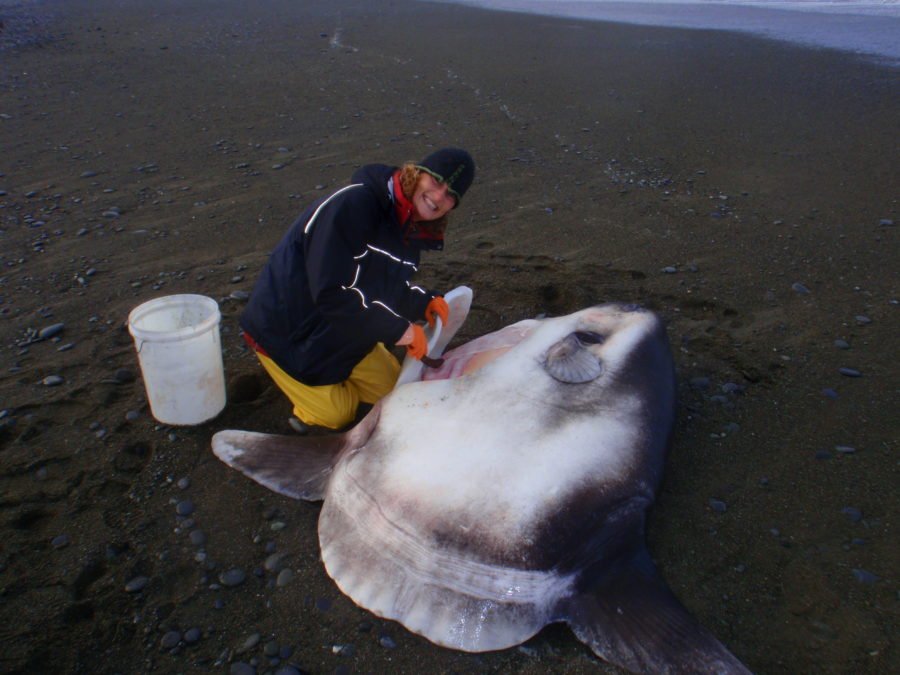Under the radar: Hoodwinker sunfish discovered

A NEW SPECIES OF ocean sunfish has been discovered in Australian and New Zealand waters by a team of international researchers.
The new species, dubbed the ‘Hoodwinker Sunfish’ (Mola tecta) after its elusive nature, is the first new addition to the sunfish genus for almost 130 years.
PhD Candidate Marianne Nyegaard from the School of Veterinary and Life Sciences at Murdoch University led the four-year study tasked with identifying the unknown species.
“A Japanese research group first found genetic evidence of an unknown sunfish species in Australian waters 10 years ago, but the fish kept eluding the scientific community because we didn’t know what it looked like,” Marianne said.
The PhD student explained that finding the fish and storing specimens was a logistical nightmare due to their elusive nature and large size.
Nevertheless, over a three year period Marianne and her team collected data from 27 Hoodwinker sunfish.

The hoodwinked sunfish. (Image Credit: César Villarroel, ExploraSub)
The researchers often had to travel thousands of kilometres to study stranded specimens of the newly discovered fish, but also relied heavily on the kindness of strangers to collect samples and data from sunfish beached along shores.
What’s unique about the Hoodwinker sunfish?
The Hoodwinker sunfish looks quite different to other sunfish species, Marianne told Australian Geographic – when you know what to look for. Instead of developing different size-dependent characteristics as the fish grows, both small and large hoodwinkers look more or less the same.
“When sunfish are small the different species look pretty similar, but as they grow older they develop different characteristics. The sister species Mola ramsayi grows this big, bizarre head bump, a big chin and swollen side-lumps, while the Mola mola species is characterised by a lumpy ‘tail’,” she explained.
“The Hoodwinker doesn’t grow these big lumps or bumps. They stay quite sleek and slender all through their life, and the skin structure is a dead give-away.”
Generally, a giant sunfish uses its dorsal and anal fins to swim, while the ‘tail’ (called a clavus) is used for steering. There’s a band of soft skin on the backend of sunfish that allows them to movethe fins and clavus, much like our lips, Marianne said.
One of the different features on the Hoodwinker is that it has developed increased flexibility of its clavusdue to a little back-fold in the smooth band, diving the clavus into and upper and lower portion.

From left: Marianne Nyegaard, Dr. Etsuro Sawai, Andrew Stewart. (Image Credit: Salme Kortet)
How did this giant fish go undetected for so long?
The history of the sunfish is plagued by scientific confusion.
Marianne explained that for centuries people have been captivated by the giant sunfish for their alien appearance, so much so that there remains thousands of different, varying accounts of human interaction with this marine oddity, dating all the way back to the histories written by Pliny the Elder.
When the interest in sunfish took off in Europe in the 16th century, Marianne told Australian Geographic that the number of species of sunfish started to grow.
“People just started describing sunfishes left, right and centre. As fish biology expanded from Europe to include other parts of the world, as naturalists joined long sea voyages to far-flung parts of the planet, new sunfish species were added. However, in the late 1800s the scientific community started to think ‘guys these fish are actually all the same’.”
According to Marianne, after a review was conducted in the 1950s of all the countless species of sunfish described, biologists came to the conclusion that there was only two species of sunfish in the genus Mola — mola ramsayi and the Mola mola species.
“Because neither of these species were terribly well described, people in New Zealand and Australia, where fish science arrived relatively late, just assumed all the different shaped and sized sunfish they saw belonged to either of these two species,” said Marianne.
“But once you know what to look for the third species becomes quite obvious.
Marianne however does concede that today’s scientists have a number of advantages over old explorers, including, “genetic tools, digital cameras, social media, digitised versions of long-forgotten books and publications, museums with fish collections, and easy communication between international team members,” which she said, “were key to solving the mystery!”
READ MORE:

